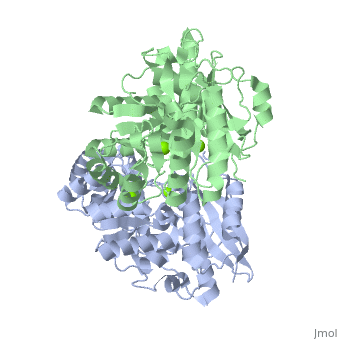3fyy
From Proteopedia
Crystal structure of divergent enolase from Oceanobacillus iheyensis complexed with Mg
Structural highlights
FunctionGALRD_OCEIH Catalyzes the regioselective dehydration of galactarate into 2-keto-D-threo-4,5-dihydroxyadipate ((2S,3R)-dihydroxy-5-oxohexanedioate). Is not active on other acid sugars.[1] Evolutionary ConservationCheck, as determined by ConSurfDB. You may read the explanation of the method and the full data available from ConSurf. Publication Abstract from PubMedThe structure of an uncharacterized member of the enolase superfamily from Oceanobacillus iheyensis (GI 23100298, IMG locus tag Ob2843, PDB entry 2OQY ) was determined by the New York SGX Research Center for Structural Genomics (NYSGXRC). The structure contained two Mg(2+) ions located 10.4 A from one another, with one located in the canonical position in the (beta/alpha)(7)beta-barrel domain (although the ligand at the end of the fifth beta-strand is His, unprecedented in structurally characterized members of the superfamily); the second is located in a novel site within the capping domain. In silico docking of a library of mono- and diacid sugars to the active site predicted a diacid sugar as a likely substrate. Activity screening of a physical library of acid sugars identified galactarate as the substrate (k(cat) = 6.8 s(-1), K(M) = 620 microM, k(cat)/K(M) = 1.1 x 10(4) M(-1) s(-1)), allowing functional assignment of Ob2843 as galactarate dehydratase (GalrD-II). The structure of a complex of the catalytically impaired Y90F mutant with Mg(2+) and galactarate allowed identification of a Tyr 164-Arg 162 dyad as the base that initiates the reaction by abstraction of the alpha-proton and Tyr 90 as the acid that facilitates departure of the beta-OH leaving group. The enzyme product is 2-keto-d-threo-4,5-dihydroxyadipate, the enantiomer of the product obtained in the GalrD reaction catalyzed by a previously characterized bifunctional l-talarate/galactarate dehydratase (TalrD/GalrD). On the basis of the different active site structures and different regiochemistries, we recognize that these functions represent an example of apparent, not actual, convergent evolution of function. The structure of GalrD-II and its active site architecture allow identification of the seventh functionally and structurally characterized subgroup in the enolase superfamily. This study provides an additional example in which an integrated sequence- and structure-based strategy employing computational approaches is a viable approach for directing functional assignment of unknown enzymes discovered in genome projects. Computation-facilitated assignment of the function in the enolase superfamily: a regiochemically distinct galactarate dehydratase from Oceanobacillus iheyensis .,Rakus JF, Kalyanaraman C, Fedorov AA, Fedorov EV, Mills-Groninger FP, Toro R, Bonanno J, Bain K, Sauder JM, Burley SK, Almo SC, Jacobson MP, Gerlt JA Biochemistry. 2009 Dec 8;48(48):11546-58. PMID:19883118[2] From MEDLINE®/PubMed®, a database of the U.S. National Library of Medicine. See AlsoReferences
| ||||||||||||||||||||


